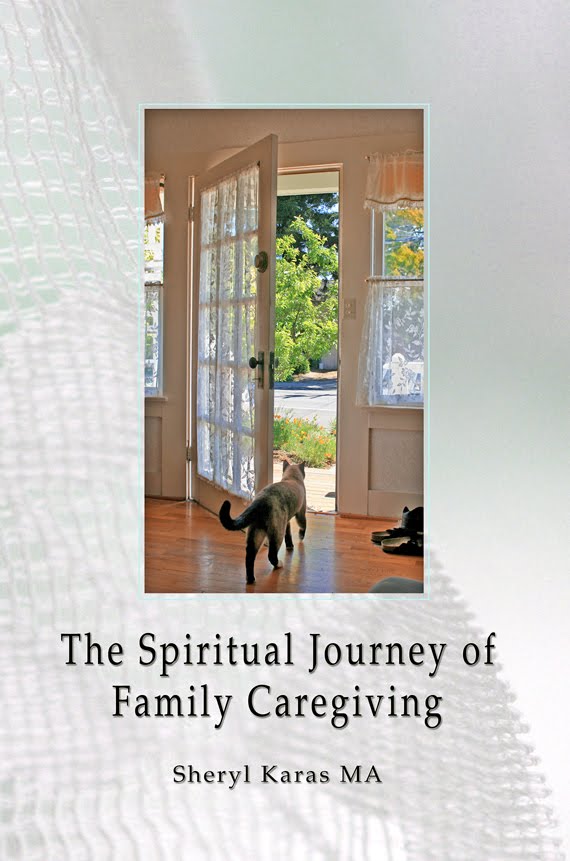
I used to work as a Family Caregiving Consultant for the Alzheimer's Association and later for Del Mar Caregiver Resource Center in Santa Cruz, CA. Conflict resolution was one of the most challenging aspects of long term family caregiving -- so many factors to be worked out, and such committed and heartfelt views. Here are some excerpts from an article I wrote on the subject back then. A new version of this can be found in my latest book, The Spiritual Journey of Family Caregiving. The book can be found both on my own website and though my shop on Etsy.com.
----
Sometimes when I work with families I think of my clients as being on a see-saw. One person in the family voices a very strong opinion about what HAS to happen and another family member insists in an equally loud voice that he or she wants the opposite. The balance of power wildly swings back and forth until one person falls off and the other person (merrily?) goes on their way doing exactly what they want without interference. (Then they come to complain to me that no one in the family "gives a damn" about the person they're taking care of so they have to do everything!)
When I was a kid my friends and I liked to play the see-saw game where the idea was to learn how to keep the see-saw in a balanced position. This was possible but very hard to maintain sitting way out at the ends. But as we learned to move our seats closer and closer towards each other we would eventually get to the point where we could sit in balance with almost no effort at all.
As an adult I forgot the see-saw game and I certainly never applied it to the game of life; but if the laws of physics are, in fact, the laws of nature, then why wouldn't they apply to interactions between people and not just interactions between objects? Let's explore that concept in the arena of conflict in general and then apply it to family caregiving. I'll start with an example from my life.
When I was in my early 20's I had a conversation with a wise elder of the Wampanoag Indian tribe in Massachusetts that made a lasting impression on me. I wanted to change the world, was a staunch vegetarian, and believed that how I lived and the food I ate (or didn't eat) was an integral part of my overall mission. Yet I couldn't understand why my family and many other people rejected my behavior with such vehemence —after all, I was on the side of what was right and good, wasn't I?
Manitonquat said he admired the motivation behind my choices but believed strongly himself that the extremity of my stance was counterproductive. His choice was to teach the sacredness of all things, ourselves included, and to help people feel grateful to the animals and plants that gave their lives for our sustenance. He wanted to help people love the earth and make sure to treat it well regardless of what one ate. He believed that if he could help get mainstream Americans, through love, to only eat as much meat as they needed and to start by experimenting with other yummy protein sources one day a week it would have a much greater impact than converting a small group of people to become total vegetarians (which might not be a sound choice for the planet, in his opinion, anyway).
Now, of course, I didn't really understand what he was talking about until many years later when his words came ringing home. I chose to give up being a vegetarian to cope with serious health concerns and couldn't believe the condemnation I heard from my vegetarian friends for "giving in." Their polarized stance made me feel unloved and angry because I realized if they couldn't support me in a life choice that had an obvious and immediately beneficial impact on my personal well-being, how could they ever expect anyone else to respect their (my old) perspective about what was best for the well-being of the planet (i.e. all of us)? The damage inherent in polarized politics became painfully apparent to me in that moment, as it has quite often in recent times. Now, as a family consultant, I see the impact polarized positions create in the lives of caregivers and, ultimately, in the lives of the people they care for.
On the polarized ends of the see-saw are always two people who are absolutely commited to what they believe is right; yet, it is a rare moment when I see people acknowledge that their commitment is a beautiful thing they have in common! In fact, the reason people often take polarized stances is to counterbalance an extreme position on the other side. Their commitment to justice and fair play, if not love, is what creates the imbalance AND it is that very commitment that can turn things around if they apply the laws of nature skillfully.
Remember, the see-saw game? The way to create balance easily without taking extreme positions is for both people to move closer together. You have to look for sources of commonality and learn to acknowledge what is right about each other's perspective. This is easier said than done but if people didn't have the goal of making things go well (at least from the perspective they see things from) there wouldn't be an argument in the first place. We all want things to go well -- hooray! -- let's see how that can be done.
The most charged and most typical family argument I see every day is the one around the decision to place mom or dad in a nursing home. One sibling, usually a devoted daughter, insists that mom (it's usually the mother) should get to live at home to the bitter end no matter what it takes while other family members believe a nursing home or residential care facility is a better choice. The one who wants mom at home will often say the others obviously don't care about mom—mom always said she'd rather die than be placed in the nursing homes she remembers from her childhood -- and the right thing, the moral thing, is obviously to keep her at home. The other family members feel condemned—they know mom might have a difficult emotional transition to make—but they also see how full-time caregiving is destroying the life of the one who is primarily in charge and, for a wide variety of reasons, they can't or won't do what little sister has done.
So they express themselves in a polarized way to counter the criticism they feel: "No! You're wrong! You're not doing a good enough job! Mom would be better off with her own peer group with trained professionals taking care of her needs!" They believe this is a loving stance, a statement of how much they do care for their parent, but it doesn't come across this way.
Neither side feels heard, both sides feel condemned and unsupported, and the impasse remains in place. What usually happens is the one who wants mom home insists on doing it no matter what and, because other family members don't agree, she gets no help. The breach in family relationships that happens as a result is often never repaired.
But what would happen if one person came closer to the middle of the see-saw and said, "I hear how much you love mom and how much you are trying to meet her needs. Tell me more. How did you come to believe this is the best solution?"
If one person felt truly heard, loved and acknowledged wouldn't they eventually be curious about why their so very loving sibling believed the opposite? Old family arguments and long-standing roles and dynamics obviously play a role in this but often the simple skill of learning to listen when everything inside is screaming "NO! LISTEN TO ME!" makes the biggest difference. Then, of course, it's important to take your turn so the reasons behind your stance are heard as well but that often has to come second.
Then what? Well, I've seen so many different solutions to this particular impasse I find myself amazed at the levels human creativity can achieve when everyone is in alignment with the highest good of everyone involved. If little sister is exhausted by being the primary caregiver and big sister can't help because she lives several states away but is willing to help pay for a nursing home maybe that money could be used for respite care instead. Maybe younger brother who is too emotionally distraught around his parents to want to be involved can be convinced to handle financial arrangements or caregiving responsibilities that don't involve hands-on care. Some people choose to use a nursing facility but come and take their relative out for a walk or a treat every day. Maybe if little sister met Mary, the friend of the family who LOVES her assisted living arrangement, she wouldn't feel so bad about helping mom adjust to a new home. Maybe if mom visited Mary and joined her for a meal and activity session she would suggest moving herself. (I actually HAVE seen this last scenario many more times than once!) But before any of these possibilities can happen, people have to be willing to move their seats closer to the center of the see-saw.

